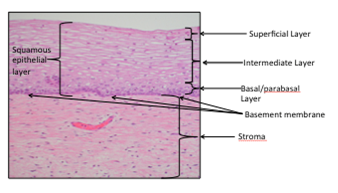This content is also available in:
Italiano
Português
Deutsch
Squamous epithelium of the cervix and vagina is non-keratinising and is composed of a continuous layer of stratified (multi-layered) flat, polygonal cells with centrally located nuclei. The stratified squamous epithelium of the cervix can be divided into three layers: the superficial, intermediate and parabasal/basal layer. Stratified squamous epithelium has a mainly protective function but also plays a vital role in the maintenance of vaginal pH.
- The superficial layer consists of mature superficial cells, which are non-keratinised although the cells may contain keratohyaline granules: the nuclei of these cells are small and pyknotic and the cytoplasm abundant and flattened. These cells are no longer maturing and readily exfoliate. This layer may present a basket-weave pattern with inconspicuous cytoplasm that may mimic koilocytosis.
- The intermediate layer consists of maturing squamous cells with vesicular, slightly larger nuclei. The amount of cytoplasm increases as the cells mature; cells of both the superficial and intermediate layers are rich in glycogen in an oestrogenised cervix.
- The parabasal/basal cell layer is a few cells thick and consists of cells with less cytoplasm and larger nuclei than the intermediate layer arising from a single layer of basal cells lying on the basement membrane. This layer is potentially generative: evidence of mitotic activity may be seen (MIB-1 positivity) in occasional basal and parabasal cells.


